編輯:關於Android編程
一、 實現拍照、選擇圖片並裁剪圖片效果
按照之前博客的風格,首先看下實現效果。
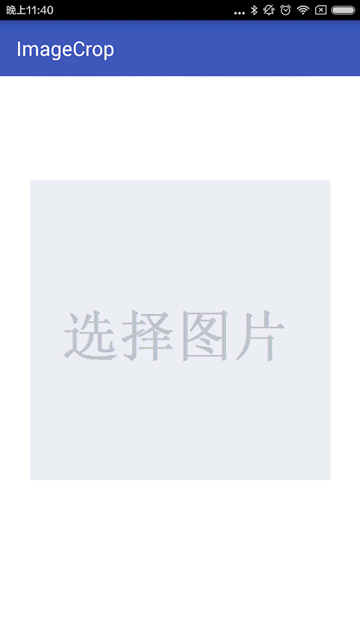
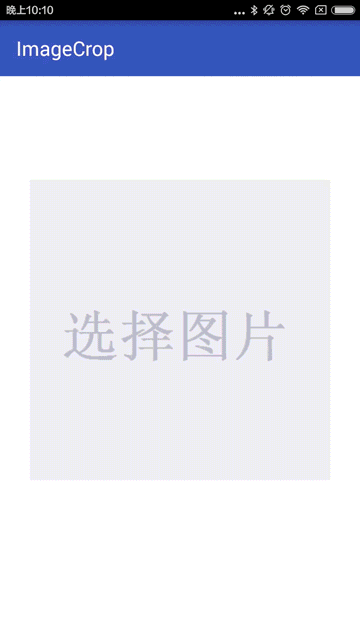
二、 uCrop項目應用
想起之前看到的Yalantis/uCrop效果比較絢,但是研究源碼之後發現在定制界面方面還是有一點的限制,於是在它的基礎上做了修改Android-Crop,把定制界面獨立出來,讓用戶去自由設置。下圖為使用Android-Crop實現的模仿微信選擇圖片並裁剪Demo。
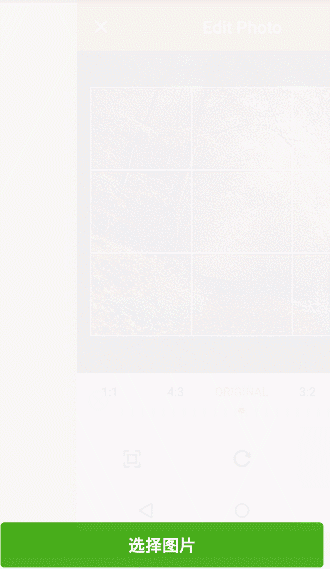
三、 實現思路
比較簡單的選擇設備圖片裁剪,並將裁剪後的圖片保存到指定路徑;
調用系統拍照,將拍照圖片保存在SD卡,然後裁剪圖片並將裁剪後的圖片保存在指定路徑。
流程圖如下所示:
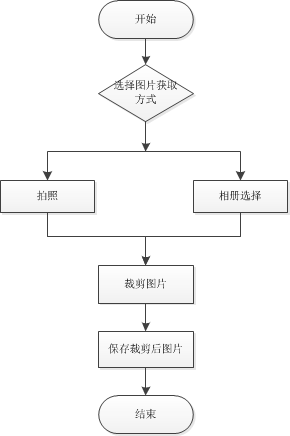
四、 選擇框實現
這裡通過PopupWindow來實現,當然也可以根據需求采用其他方式實現。實現效果如下圖所示:
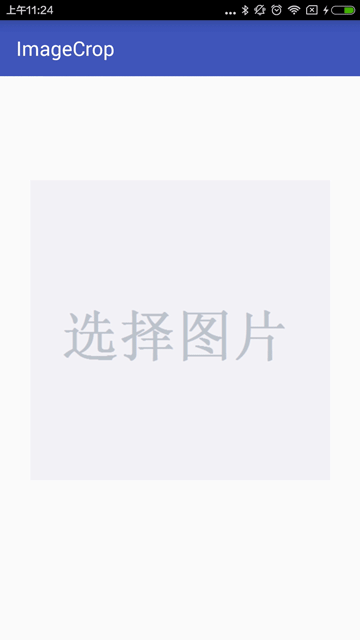
1. XML布局
<?xml version="1.0" encoding="utf-8"?> <RelativeLayout xmlns:android="http://schemas.android.com/apk/res/android" android:layout_width="fill_parent" android:layout_height="wrap_content" android:gravity="center_horizontal" android:orientation="vertical"> <LinearLayout android:id="@+id/pop_layout" android:layout_width="match_parent" android:layout_height="wrap_content" android:layout_alignParentBottom="true" android:background="#444" android:gravity="center_horizontal" android:orientation="vertical"> <Button android:id="@+id/picture_selector_take_photo_btn" android:layout_width="match_parent" android:layout_height="wrap_content" android:layout_marginLeft="10dip" android:layout_marginRight="10dip" android:layout_marginTop="10dp" android:background="#4d69ff" android:padding="10dp" android:text="拍照" android:textColor="#CEC9E7" android:textSize="18sp" android:text /> <Button android:id="@+id/picture_selector_pick_picture_btn" android:layout_width="match_parent" android:layout_height="wrap_content" android:layout_marginLeft="10dip" android:layout_marginRight="10dip" android:layout_marginTop="5dp" android:background="#4d69ff" android:padding="10dp" android:text="從相冊選擇" android:textColor="#CEC9E7" android:textSize="18sp" android:text /> <Button android:id="@+id/picture_selector_cancel_btn" android:layout_width="match_parent" android:layout_height="wrap_content" android:layout_marginBottom="15dip" android:layout_marginLeft="10dip" android:layout_marginRight="10dip" android:layout_marginTop="20dp" android:background="@android:color/white" android:padding="10dp" android:text="取消" android:textColor="#373447" android:textSize="18sp" android:text /> </LinearLayout> </RelativeLayout>
2. 代碼編寫
public SelectPicturePopupWindow(Context context) {
super(context);
LayoutInflater inflater = (LayoutInflater) context.getSystemService(Context.LAYOUT_INFLATER_SERVICE);
mMenuView = inflater.inflate(R.layout.layout_picture_selector, null);
takePhotoBtn = (Button) mMenuView.findViewById(R.id.picture_selector_take_photo_btn);
pickPictureBtn = (Button) mMenuView.findViewById(R.id.picture_selector_pick_picture_btn);
cancelBtn = (Button) mMenuView.findViewById(R.id.picture_selector_cancel_btn);
// 設置按鈕監聽
takePhotoBtn.setOnClickListener(this);
pickPictureBtn.setOnClickListener(this);
cancelBtn.setOnClickListener(this);
}
創建SelectPicturePopupWindow的時候設置按鈕的監聽。這裡編寫一個選擇監聽接口:
/**
* 選擇監聽接口
*/
public interface OnSelectedListener {
void OnSelected(View v, int position);
}
回調的參數為點擊的按鈕View以及當前按鈕的索引,那麼只要在選擇監聽裡面返回接口的回調就可以啦。
@Override
public void onClick(View v) {
switch (v.getId()) {
case R.id.picture_selector_take_photo_btn:
if(null != mOnSelectedListener) {
mOnSelectedListener.OnSelected(v, 0);
}
break;
case R.id.picture_selector_pick_picture_btn:
if(null != mOnSelectedListener) {
mOnSelectedListener.OnSelected(v, 1);
}
break;
case R.id.picture_selector_cancel_btn:
if(null != mOnSelectedListener) {
mOnSelectedListener.OnSelected(v, 2);
}
break;
}
}
PopupWindow的初始化創建、監聽設置好之後,只要提供顯示與隱藏兩個方法就可以了。
/**
* 把一個View控件添加到PopupWindow上並且顯示
*
* @param activity
*/
public void showPopupWindow(Activity activity) {
popupWindow = new PopupWindow(mMenuView, // 添加到popupWindow
ViewGroup.LayoutParams.MATCH_PARENT, ViewGroup.LayoutParams.WRAP_CONTENT);
popupWindow.setBackgroundDrawable(new ColorDrawable(Color.TRANSPARENT));
popupWindow.showAtLocation(activity.getWindow().getDecorView(), Gravity.CENTER | Gravity.BOTTOM, 0, 0);
popupWindow.setAnimationStyle(android.R.style.Animation_InputMethod); // 設置窗口顯示的動畫效果
popupWindow.setFocusable(false); // 點擊其他地方隱藏鍵盤 popupWindow
popupWindow.update();
}
/**
* 移除PopupWindow
*/
public void dismissPopupWindow() {
if (popupWindow != null && popupWindow.isShowing()) {
popupWindow.dismiss();
popupWindow = null;
}
}
OK,到這裡選擇框的實現就完成了。
五、使用選擇框
通過我們上面對選擇框的封裝,使用起來就比較簡單了,只需要初始化及設置選擇的監聽就可以啦。
1.初始化選擇框
mSelectPicturePopupWindow = new SelectPicturePopupWindow(mContext); mSelectPicturePopupWindow.setOnSelectedListener(this);
2.設置選擇框監聽
@Override
public void OnSelected(View v, int position) {
switch (position) {
case 0:
// TODO: "拍照"按鈕被點擊了
break;
case 1:
// TODO: "從相冊選擇"按鈕被點擊了
break;
case 2:
// TODO: "取消"按鈕被點擊了
break;
}
}
然後在Fragment上進行封裝,我們取名為PictureSelectFragment。
六、拍照並保存圖片
調用系統的拍照,並把拍攝的圖片保存到指定位置。
@Override
public void OnSelected(View v, int position) {
switch (position) {
case 0:
// "拍照"按鈕被點擊了
mSelectPicturePopupWindow.dismissPopupWindow();
Intent takeIntent = new Intent(MediaStore.ACTION_IMAGE_CAPTURE);
//下面這句指定調用相機拍照後的照片存儲的路徑
takeIntent.putExtra(MediaStore.EXTRA_OUTPUT, Uri.fromFile(new File(mTempPhotoPath)));
startActivityForResult(takeIntent, CAMERA_REQUEST_CODE);
break;
case 1:
// TODO: "從相冊選擇"按鈕被點擊了
break;
case 2:
// TODO: "取消"按鈕被點擊了
break;
}
}
這裡的指定位置為sd卡本目錄下
mTempPhotoPath = Environment.getExternalStorageDirectory() + File.separator + "photo.jpeg";
當拍攝照片完成時會回調到onActivityResult,我們在這裡處理圖片的裁剪就可以了。
@Override
public void onActivityResult(int requestCode, int resultCode, Intent data) {
if (resultCode == mActivity.RESULT_OK) {
switch (requestCode) {
case CAMERA_REQUEST_CODE:
// TODO: 調用相機拍照
break;
}
}
super.onActivityResult(requestCode, resultCode, data);
}
七、相冊選擇圖片
調用系統的選擇圖片
@Override
public void OnSelected(View v, int position) {
switch (position) {
case 0:
// "拍照"按鈕被點擊了
mSelectPicturePopupWindow.dismissPopupWindow();
Intent takeIntent = new Intent(MediaStore.ACTION_IMAGE_CAPTURE);
// 下面這句指定調用相機拍照後的照片存儲的路徑
takeIntent.putExtra(MediaStore.EXTRA_OUTPUT, Uri.fromFile(new File(mTempPhotoPath)));
startActivityForResult(takeIntent, CAMERA_REQUEST_CODE);
break;
case 1:
// "從相冊選擇"按鈕被點擊了
mSelectPicturePopupWindow.dismissPopupWindow();
Intent pickIntent = new Intent(Intent.ACTION_PICK, null);
// 如果限制上傳到服務器的圖片類型時可以直接寫如:"image/jpeg 、 image/png等的類型"
pickIntent.setDataAndType(MediaStore.Images.Media.EXTERNAL_CONTENT_URI, "image/*");
startActivityForResult(pickIntent, GALLERY_REQUEST_CODE);
break;
case 2:
// TODO: "取消"按鈕被點擊了
break;
}
}
當拍選擇圖片完成時會回調到onActivityResult,在這裡處理選擇的返回結果。
@Override
public void onActivityResult(int requestCode, int resultCode, Intent data) {
if (resultCode == mActivity.RESULT_OK) {
switch (requestCode) {
case CAMERA_REQUEST_CODE:
// TODO: 調用相機拍照
break;
case GALLERY_REQUEST_CODE:
// TODO: 直接從相冊獲取
break;
}
}
super.onActivityResult(requestCode, resultCode, data);
}
八、使用Crop裁剪圖片
裁剪圖片,這裡設置寬高比為1:1,最大尺寸為512*512,當然可以根據自己的需求來設置。
/**
* 裁剪圖片方法實現
*
* @param uri
*/
public void startCropActivity(Uri uri) {
UCrop.of(uri, mDestinationUri)
.withAspectRatio(1, 1)
.withMaxResultSize(512, 512)
.withTargetActivity(CropActivity.class)
.start(mActivity, this);
}
CropActiivty裁剪完成時會回調到onActivityResult,在這裡處理選擇的返回結果。
@Override
public void onActivityResult(int requestCode, int resultCode, Intent data) {
if (resultCode == mActivity.RESULT_OK) {
switch (requestCode) {
case CAMERA_REQUEST_CODE: // 調用相機拍照
File temp = new File(mTempPhotoPath);
startCropActivity(Uri.fromFile(temp));
break;
case GALLERY_REQUEST_CODE: // 直接從相冊獲取
startCropActivity(data.getData());
break;
case UCrop.REQUEST_CROP:
// TODO: 裁剪圖片結果
break;
case UCrop.RESULT_ERROR:
// TODO: 裁剪圖片錯誤
break;
}
}
super.onActivityResult(requestCode, resultCode, data);
}
CropActivity的界面如下所示:
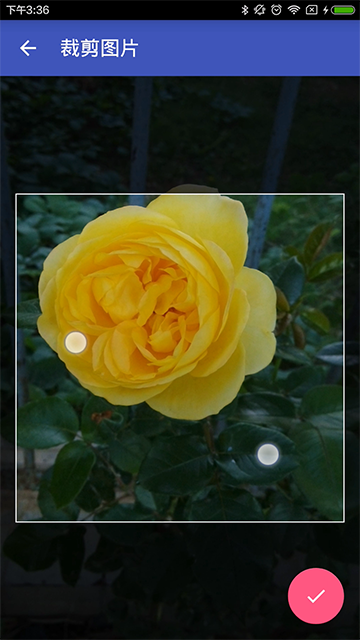
當然也可以輕松設計成如下兩圖:
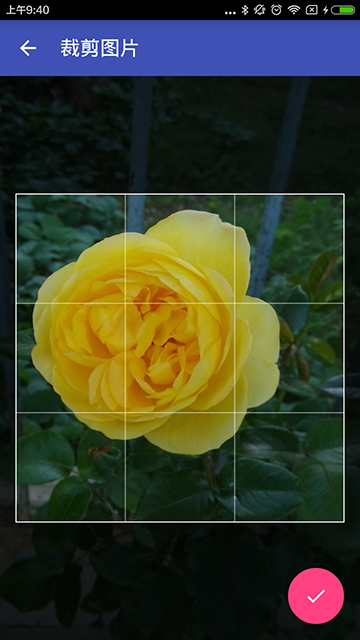
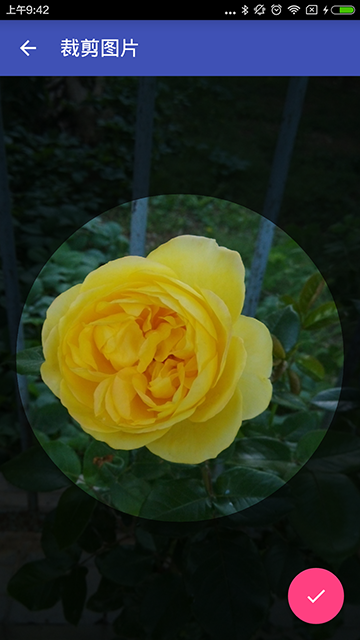
1. XML布局
<RelativeLayout xmlns:android="http://schemas.android.com/apk/res/android" xmlns:fab="http://schemas.android.com/apk/res-auto" android:layout_width="match_parent" android:layout_height="match_parent" android:clipToPadding="true" android:fitsSystemWindows="true"> <include layout="@layout/toolbar_layout" /> <FrameLayout android:layout_width="match_parent" android:layout_height="match_parent" android:layout_below="@+id/toolbar" android:background="#000"> <com.kevin.crop.view.UCropView android:id="@+id/weixin_act_ucrop" android:layout_width="match_parent" android:layout_height="match_parent" android:visibility="invisible" /> </FrameLayout> <android.support.design.widget.CoordinatorLayout android:layout_width="match_parent" android:layout_height="match_parent"> <android.support.design.widget.FloatingActionButton android:id="@+id/crop_act_save_fab" android:layout_width="wrap_content" android:layout_height="wrap_content" android:layout_gravity="bottom|right" android:layout_margin="@dimen/fab_margin" android:src="@mipmap/ic_done_white" fab:fabSize="normal" /> </android.support.design.widget.CoordinatorLayout> </RelativeLayout>
可以發現非常簡單,只有一個主要的CropView,這就是uCrop框架為我們提供的。
2. 代碼編寫
@Override
protected void initViews() {
initToolBar();
mGestureCropImageView = mUCropView.getCropImageView();
mOverlayView = mUCropView.getOverlayView();
// 設置允許縮放
mGestureCropImageView.setScaleEnabled(true);
// 設置禁止旋轉
mGestureCropImageView.setRotateEnabled(false);
// 設置外部陰影顏色
mOverlayView.setDimmedColor(Color.parseColor("#AA000000"));
// 設置周圍陰影是否為橢圓(如果false則為矩形)
mOverlayView.setOvalDimmedLayer(false);
// 設置顯示裁剪邊框
mOverlayView.setShowCropFrame(true);
// 設置不顯示裁剪網格
mOverlayView.setShowCropGrid(false);
final Intent intent = getIntent();
setImageData(intent);
}
private void setImageData(Intent intent) {
Uri inputUri = intent.getParcelableExtra(UCrop.EXTRA_INPUT_URI);
mOutputUri = intent.getParcelableExtra(UCrop.EXTRA_OUTPUT_URI);
if (inputUri != null && mOutputUri != null) {
try {
mGestureCropImageView.setImageUri(inputUri);
} catch (Exception e) {
setResultException(e);
finish();
}
} else {
setResultException(new NullPointerException("Both input and output Uri must be specified"));
finish();
}
// 設置裁剪寬高比
if (intent.getBooleanExtra(UCrop.EXTRA_ASPECT_RATIO_SET, false)) {
float aspectRatioX = intent.getFloatExtra(UCrop.EXTRA_ASPECT_RATIO_X, 0);
float aspectRatioY = intent.getFloatExtra(UCrop.EXTRA_ASPECT_RATIO_Y, 0);
if (aspectRatioX > 0 && aspectRatioY > 0) {
mGestureCropImageView.setTargetAspectRatio(aspectRatioX / aspectRatioY);
} else {
mGestureCropImageView.setTargetAspectRatio(CropImageView.SOURCE_IMAGE_ASPECT_RATIO);
}
}
// 設置裁剪的最大寬高
if (intent.getBooleanExtra(UCrop.EXTRA_MAX_SIZE_SET, false)) {
int maxSizeX = intent.getIntExtra(UCrop.EXTRA_MAX_SIZE_X, 0);
int maxSizeY = intent.getIntExtra(UCrop.EXTRA_MAX_SIZE_Y, 0);
if (maxSizeX > 0 && maxSizeY > 0) {
mGestureCropImageView.setMaxResultImageSizeX(maxSizeX);
mGestureCropImageView.setMaxResultImageSizeY(maxSizeY);
} else {
Log.w(TAG, "EXTRA_MAX_SIZE_X and EXTRA_MAX_SIZE_Y must be greater than 0");
}
}
}
以上為CropView的配置,更多配置請參考項目源碼。
最重要的,裁剪保存圖片:
private void cropAndSaveImage() {
OutputStream outputStream = null;
try {
final Bitmap croppedBitmap = mGestureCropImageView.cropImage();
if (croppedBitmap != null) {
outputStream = getContentResolver().openOutputStream(mOutputUri);
croppedBitmap.compress(Bitmap.CompressFormat.JPEG, 85, outputStream);
croppedBitmap.recycle();
setResultUri(mOutputUri, mGestureCropImageView.getTargetAspectRatio());
finish();
} else {
setResultException(new NullPointerException("CropImageView.cropImage() returned null."));
}
} catch (Exception e) {
setResultException(e);
finish();
} finally {
BitmapLoadUtils.close(outputStream);
}
}
PictureSelectFragment處理裁剪成功的返回值
/**
* 處理剪切成功的返回值
*
* @param result
*/
private void handleCropResult(Intent result) {
deleteTempPhotoFile();
final Uri resultUri = UCrop.getOutput(result);
if (null != resultUri && null != mOnPictureSelectedListener) {
Bitmap bitmap = null;
try {
bitmap = MediaStore.Images.Media.getBitmap(mActivity.getContentResolver(), resultUri);
} catch (FileNotFoundException e) {
e.printStackTrace();
} catch (IOException e) {
e.printStackTrace();
}
mOnPictureSelectedListener.onPictureSelected(resultUri, bitmap);
} else {
Toast.makeText(mContext, "無法剪切選擇圖片", Toast.LENGTH_SHORT).show();
}
}
處理裁剪失敗的返回值
/**
* 處理剪切失敗的返回值
*
* @param result
*/
private void handleCropError(Intent result) {
deleteTempPhotoFile();
final Throwable cropError = UCrop.getError(result);
if (cropError != null) {
Log.e(TAG, "handleCropError: ", cropError);
Toast.makeText(mContext, cropError.getMessage(), Toast.LENGTH_LONG).show();
} else {
Toast.makeText(mContext, "無法剪切選擇圖片", Toast.LENGTH_SHORT).show();
}
}
這裡設置了選擇的回調接口,便於封裝抽取。
/**
* 圖片選擇的回調接口
*/
public interface OnPictureSelectedListener {
/**
* 圖片選擇的監聽回調
*
* @param fileUri
* @param bitmap
*/
void onPictureSelected(Uri fileUri, Bitmap bitmap);
}
經過五、六、七步驟,我們的PictureSelectFragment就搞定了,在使用的時候只要繼承它,幾行代碼就搞定了。
九、PictureSelectFragment使用
// 設置圖片點擊監聽
mPictureIv.setOnClickListener(new View.OnClickListener() {
@Override
public void onClick(View v) {
selectPicture();
}
});
// 設置裁剪圖片結果監聽
setOnPictureSelectedListener(new OnPictureSelectedListener() {
@Override
public void onPictureSelected(Uri fileUri, Bitmap bitmap) {
mPictureIv.setImageBitmap(bitmap);
String filePath = fileUri.getEncodedPath();
String imagePath = Uri.decode(filePath);
Toast.makeText(mContext, "圖片已經保存到:" + imagePath, Toast.LENGTH_LONG).show();
}
});
OK,經過我們上面的封裝及基類抽取,在使用的時候還是非常簡單的。
十、下載
源碼及示例
用到的Android-Crop庫
更多內容大家可以參考專題《Android圖片處理》進行學習。
以上就是本文的全部內容,希望對大家學習Android軟件編程有所幫助。
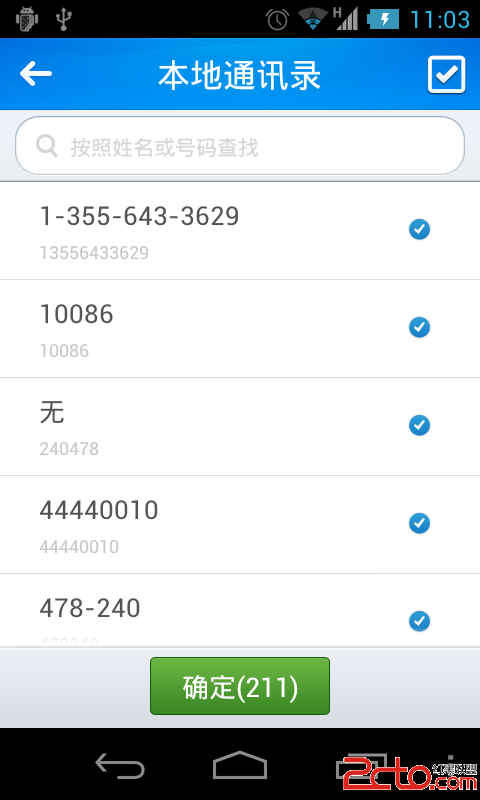 Android通訊錄開發之實現全選、反選功能
Android通訊錄開發之實現全選、反選功能
Android通訊錄開發之實現全選、反選功能 2014年1月15日 實現全選、反選不是什麼難的事情,就只是用另外一個數據結構來存儲被選中的狀態,通過刷新列表
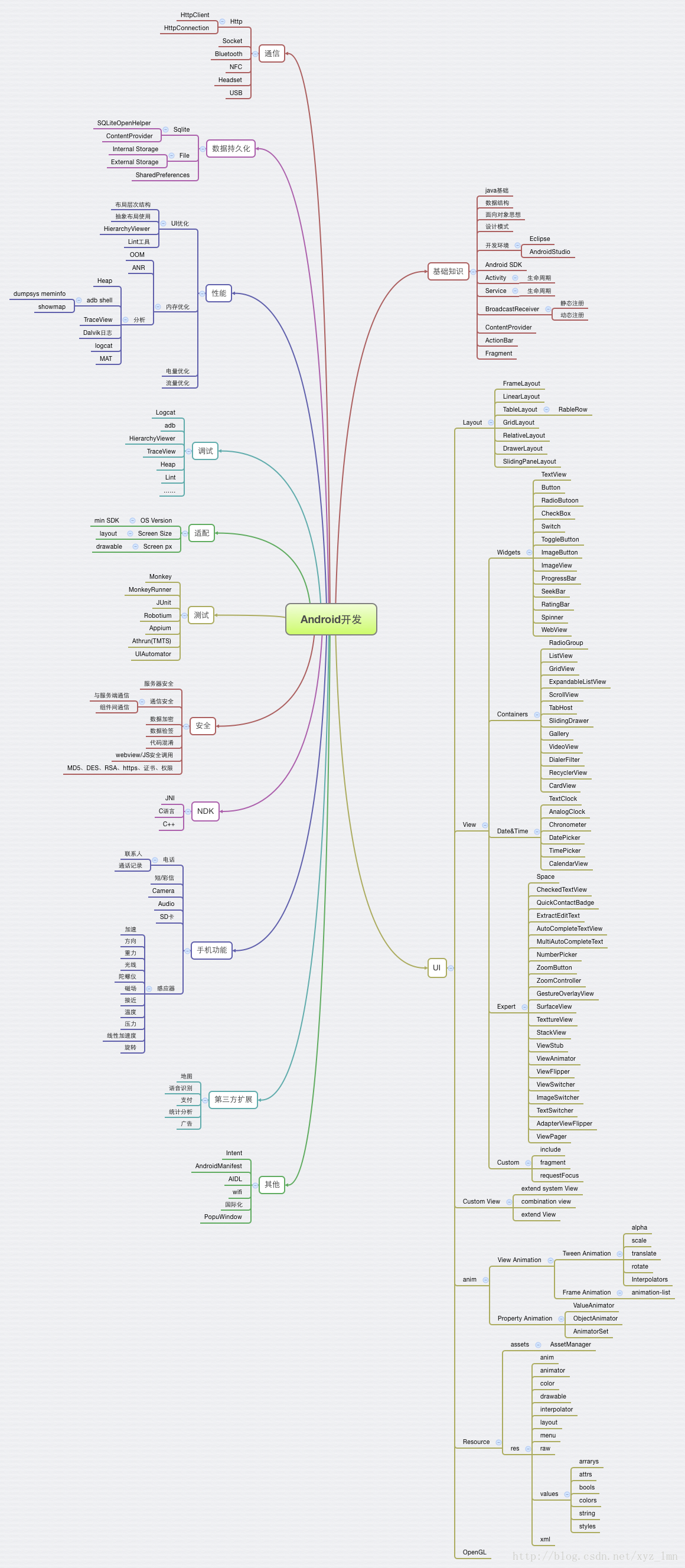 Android知識體系圖
Android知識體系圖
參考網上的資料,制作出來一份Android知識體系圖,梳理自己所學過的知識點,以後復習會更加方便。
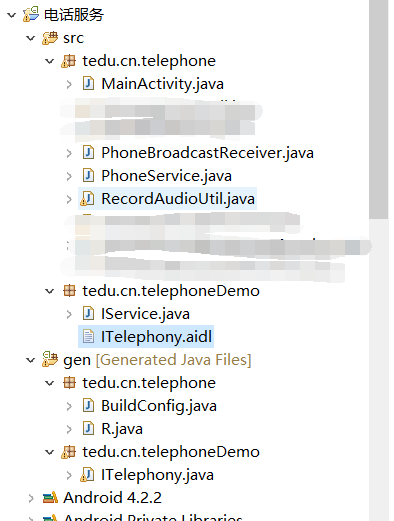 Android 電話服務(完成版)
Android 電話服務(完成版)
之前的代碼是分開寫的,並沒有實現一個完成電話相關服務,這次就給大家來一記猛藥,望大家提出寶貴意見和建議與我分享,感謝! 電話監聽主Activity
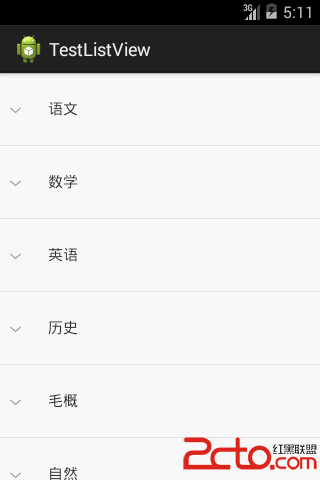 android listView二級目錄選中效果
android listView二級目錄選中效果
一.listView的二級目錄且選中實現:記錄下來,以便以後可能會用到,直接上貼源碼:先上效果圖: 主界面:public class MainActivity exten